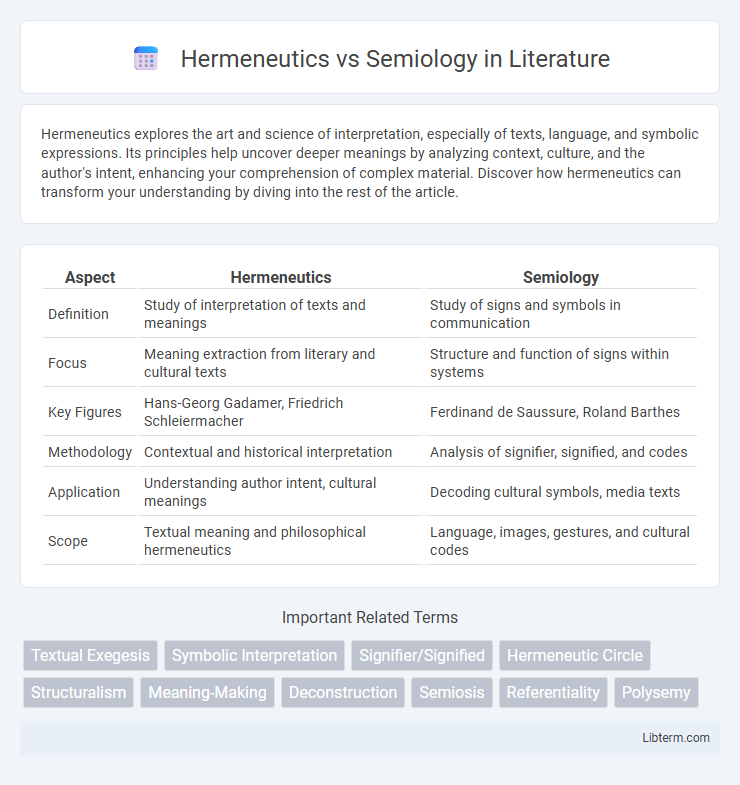Hermeneutics explores the art and science of interpretation, especially of texts, language, and symbolic expressions. Its principles help uncover deeper meanings by analyzing context, culture, and the author's intent, enhancing your comprehension of complex material. Discover how hermeneutics can transform your understanding by diving into the rest of the article.
Table of Comparison
| Aspect | Hermeneutics | Semiology |
|---|---|---|
| Definition | Study of interpretation of texts and meanings | Study of signs and symbols in communication |
| Focus | Meaning extraction from literary and cultural texts | Structure and function of signs within systems |
| Key Figures | Hans-Georg Gadamer, Friedrich Schleiermacher | Ferdinand de Saussure, Roland Barthes |
| Methodology | Contextual and historical interpretation | Analysis of signifier, signified, and codes |
| Application | Understanding author intent, cultural meanings | Decoding cultural symbols, media texts |
| Scope | Textual meaning and philosophical hermeneutics | Language, images, gestures, and cultural codes |
Introduction to Hermeneutics and Semiology
Hermeneutics explores the theory and methodology of interpretation, particularly of texts, emphasizing understanding the meaning behind language, symbols, and cultural contexts. Semiology, or semiotics, studies signs and symbols as elements of communicative behavior, analyzing how meaning is constructed and communicated through sign systems. While hermeneutics prioritizes interpretive frameworks and contextual analysis, semiology focuses on the structural relations and function of signs within language and culture.
Historical Development of Hermeneutics
Hermeneutics originated as a method for interpreting religious texts, evolving significantly during the 19th and 20th centuries through thinkers like Friedrich Schleiermacher and Hans-Georg Gadamer, who emphasized the historical and contextual analysis of meaning. In contrast, Semiology, founded by Ferdinand de Saussure, emerged as a structural study of signs and symbols within language systems, focusing on the relationship between signifier and signified. The historical development of Hermeneutics highlights its transformation from theological exegesis to a broader philosophical framework for understanding human communication and interpretation across disciplines.
Origins and Evolution of Semiology
Semiology, founded by Ferdinand de Saussure in the early 20th century, emerged as the scientific study of signs and symbols as elements of communicative behavior, distinct from hermeneutics which centers on interpretation and meaning in texts. Its evolution traces the shift from linguistics to broader cultural analyses, influencing structuralism and post-structuralism, positioning semiology as a key theoretical framework for analyzing sign systems beyond language. Unlike hermeneutics' roots in philosophy and theology emphasizing subjective understanding, semiology's development advanced through linguistics and anthropology, emphasizing systematic study of sign structures and societal codes.
Core Principles of Hermeneutics
Hermeneutics centers on interpreting texts by understanding authorial intent, historical context, and the reader's role in meaning-making, emphasizing the dynamic interaction between text and interpreter. This discipline relies on principles such as the hermeneutic circle, which highlights the interdependence of parts and whole in comprehension, and the importance of pre-understanding in shaping interpretation. Semiology, by contrast, analyzes signs and symbols within communication systems, focusing more on structural relationships rather than contextual or subjective interpretation.
Fundamental Concepts in Semiology
Semiology studies signs and symbols as fundamental elements of communication, analyzing how meaning is constructed through signifiers and signifieds within cultural contexts. Structuralist Ferdinand de Saussure's model emphasizes the arbitrary relationship between the signifier (form) and the signified (concept), highlighting how language functions as a system of differences. Hermeneutics, in contrast, focuses on interpretation and understanding of texts, prioritizing the context and the intent behind meaning rather than the structural components of signs.
Key Figures in Hermeneutics and Semiology
Key figures in hermeneutics include Hans-Georg Gadamer, known for his philosophical hermeneutics emphasizing historical context and the fusion of horizons, and Friedrich Schleiermacher, who pioneered the concept of understanding the author's intention. In semiology, Ferdinand de Saussure established foundational theories on the structural relationship between signifier and signified, while Roland Barthes expanded semiology into cultural texts and myths. These thinkers significantly shaped the interpretative frameworks within their respective fields, grounding hermeneutics in interpretative philosophy and semiology in linguistic and cultural analysis.
Interpretive Methods: Hermeneutics vs Semiology
Hermeneutics centers on interpreting texts by uncovering meaning through context, history, and authorial intent, emphasizing a dialogical process between the interpreter and the text. Semiology analyzes signs and symbols within language and culture, focusing on the structure and function of signs to decode underlying meanings and cultural codes. Both methodologies offer distinct interpretive frameworks: Hermeneutics privileges subjective understanding and the evolution of meaning, while Semiology provides systematic analysis of sign systems and their roles in communication.
Applications in Literary and Cultural Analysis
Hermeneutics emphasizes interpreting texts by uncovering underlying meanings and authorial intent, making it essential for deep literary analysis and understanding cultural contexts. Semiology, or semiotics, studies signs and symbols as part of communication systems, allowing cultural analysts to decode meanings embedded in media, artifacts, and social practices. Both frameworks enrich literary and cultural analysis by providing distinct methods to explore textual significance and cultural signification.
Comparative Strengths and Limitations
Hermeneutics excels in interpreting meaning within cultural, historical, and textual contexts, allowing deep understanding of subjective experiences, while Semiology systematically analyzes signs and symbols, providing clarity in communication structures and meaning generation. Hermeneutics faces limitations in its subjective and sometimes ambiguous interpretations, whereas Semiology can be constrained by its abstract and formalist approach, potentially overlooking nuanced human experiences. Combining both approaches enhances analytical depth by balancing contextual interpretation with structural analysis of signs.
Conclusion: Bridging Meaning and Signs
Hermeneutics emphasizes the interpretation of meaning within contexts, while semiology studies the structure and function of signs as systems of communication. Bridging these disciplines enhances understanding by linking subjective meaning with objective sign processes, facilitating a comprehensive analysis of texts and symbols. This integrated approach advances fields such as linguistics, literary theory, and cultural studies by combining interpretive depth with semiotic clarity.
Hermeneutics Infographic

 libterm.com
libterm.com